- 21st Century Cropduster -
Turbine Speeds on 25 GPH of Pump Gas
NOTE: All our Products, Designs and Services are SUSTAINABLE, ORGANIC, GLUTEN-FREE, CONTAIN NO GMO's, and will not upset anyone's precious FEELINGS or delicate SENSIBILITIES.
The agricultural industry has an extreme need for cost-effective and reliable aerial-application aircraft (AKA "cropdusters", "ag-planes").
The continuous increases in the cost of Jet-A turbine fuel has made it ever-more difficult to make a profit with a turbine-powered ag-plane. Several older types of cropduster aircraft currently in service use the antique 600-HP Pratt & Whitney R-1340 radial engine for power. A typical example is shown in the picture below.
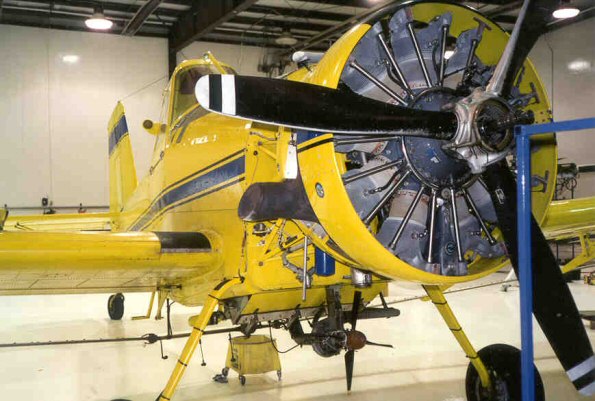
Air Tractor-301 with Original P&W R-1340 Engine
As is clear from the picture, the huge frontal area of the radial engine generates a substantial amount of aerodynamic drag, requiring large power settings to fly at a speed reasonable for the economic application of the required chemicals.
The R-1340 production ended in 1960, so the newest of these R-1340 engines is 61 years old (as of 2021). Consequently, it is becoming increasingly difficult to find parts with which to overhaul them, and the cost of an overhaul can run in excess of $50,000. The best-case service life of an overhauled radial in an Ag-plane service environment is typically about 1000 hours.
In recent years, aerial application companies have been replacing their older piston-powered aircraft with newer ag-planes equipped with TPE-331 and PT-6 turboprop engines. While the turbine engine reliability is legendary, the capital cost is very high and the hourly operational costs are increasing rapidly, especially in view of the the ever-rising cost of turbine fuel, plus the fact that turbines are notoriously thirsty at low altitude.
When the cost of jet fuel was relatively low, a 50-gallon-per-hour fuel consumption was not a significant factor in the operation of a turbine ag-plane. However, by 2018, the cost of jet fuel has made it impossible for many operators to break even (never mind make a profit) with their turbine ag-planes. As a consequence, many of the turbine-powered aircraft have been parked, rather that being flown at a loss.
One large aerial-application company recognized the opportunity created by this operational cost situation, and decided to revive the piston-powered ag-plane using a thoroughly-modernized powerplant.
That company contracted with EPI to develop a modern, high-performance 600-HP firewall-forward powerplant package to replace the aging R-1340 engines. This package was intended to provide an aerodynamically sleek installation capable of flying at airframe-redline speeds on modest power settings, using 92-octane pump gasoline, with low fuel consumption, good reliability and a reasonable conversion cost.
EPI defined and configured the powerplant and required accessories. The complete system was first completely modeled in 3D-CAD as shown here.
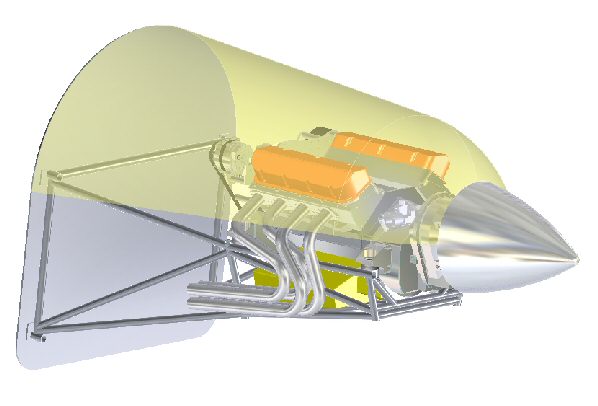
3D-CAD Model of Engine Conversion
We then designed and FEA-analyzed the engine mount structure. After design and successful analysis, we fabricated a fully-adjustable, hard fixture for the manufacture of the mount structure.
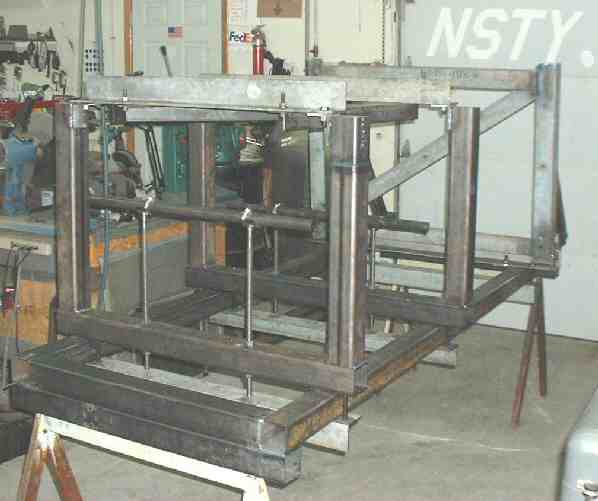
Fully-Adjustable Enging Mount Fabrication Fixture
Next, we fabricated the prototype mount structure from the design drawings.
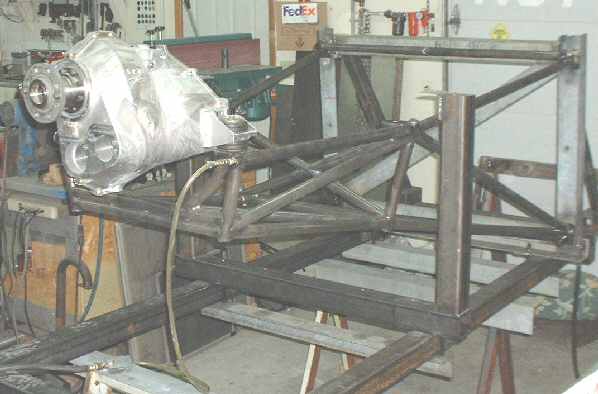
Completed 572-to-AT-301 Mount in Fixture
This mount structure carries the worst-case combination of FAR-23 loads (Torque, Thrust, Vertical-G, Horizontal-G, and Gyroscopic Moment) at just over 50% of the material yield stress, yet is very stiff, light, and provides the natural frequency separation necessary to prevent whirl mode instability.
The powerplant is based on a large, liquid-cooled V8 engine and the EPI Mark-15 propeller reduction gearbox. The engine produces about 620 HP on 92-octane auto-fuel, and is equipped with very high-grade components, including (a) a fully-counterweighted, forged steel crankshaft made from AISI-E-4340 nickel-chrome-moly alloy, (b) billet H-beam connecting rods from the same alloy, (c) forged 3-ring aluminum pistons in 2618 alloy, (d) high-flow aluminum heads with austenitic stainless valves and tailored valvesprings and retainers.
EPI replaces the OEM aluminum rocker arms with a set of high-strength, roller-tip, steel rocker arms in AISI-8650 chrome-moly alloy (essential for reliable operation at continuous high speeds). We then add a custom-designed 18-quart aircraft-application wet-sump oiling system, which provides an uninterrupted engine and gearbox oil supply in +/- 50 degrees of pitch or roll attitude excursions, as well as a purpose-designed accessory drive system with a high capacity alternator, an air-conditioning compressor and a redundant coolant pump drive (shown below).
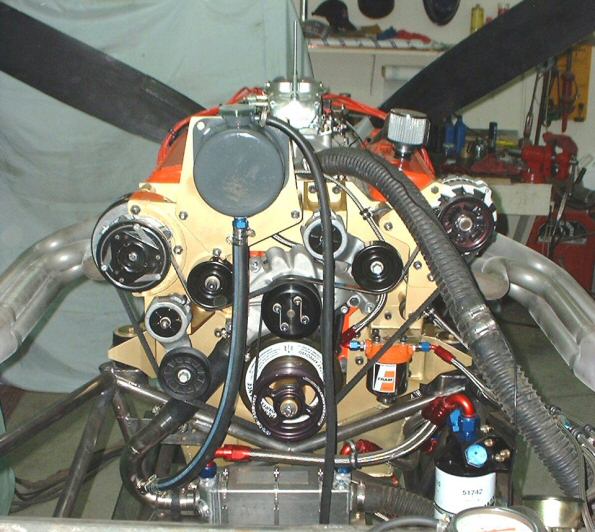
EPI Accessory Drive System for Cropduster Conversion
The picture below shows the conversion ready to hang on the prototype aircraft, where the cooling system, muffler system and cowlings will be fabricated. (Note that the picture shows a Mark-9 gearbox instead of the Mark-15, which was not complete at the time this picture was taken.)
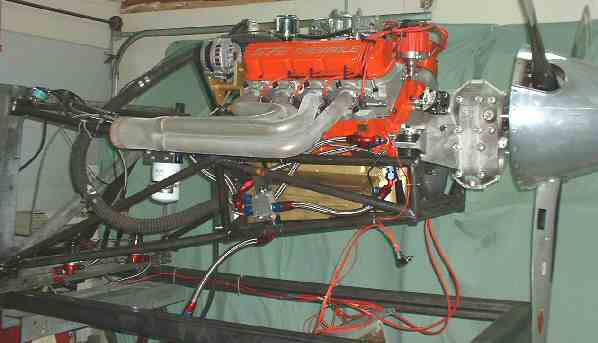
Powerplant Installed in Mount (M-9 PSRU Shown; M-15 Not Completed when Photograph Taken)
The conversion allows a 200 pound increase in payload and will fly at turbine aircraft speeds, while using less than half the fuel than a comparable turbine-powered aircraft. Initial calculations show that, as a result of the severe aerodynamic improvements from this conversion, the aircraft will be able to achieve speeds similar to those of a PT-6 powered version on less than 25 gallons per hour of 92-octane pump gas. More data will be published as the project progresses.

